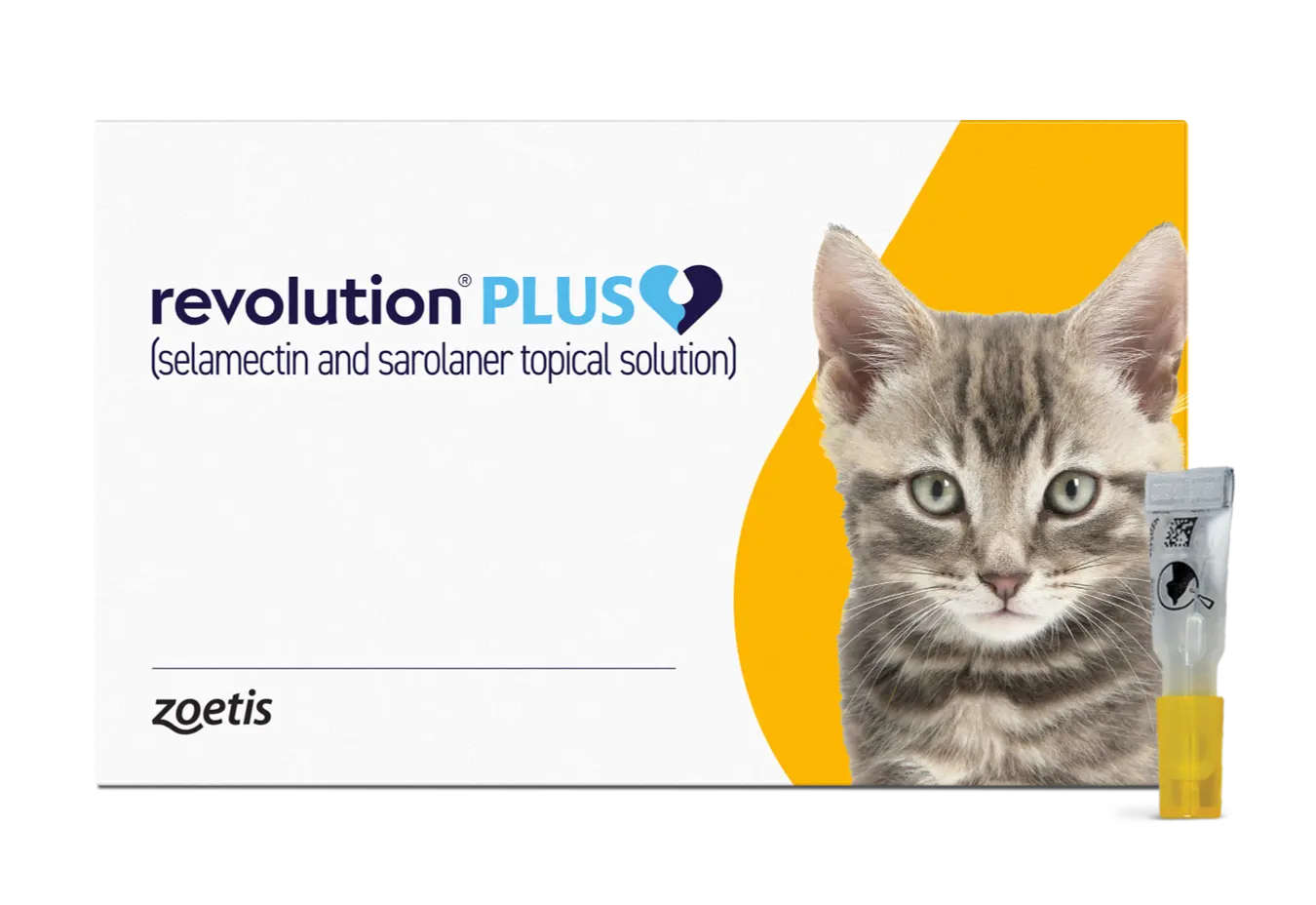
Protect Your Cat From Parasites That Follow You Home

Because Every Cat Needs Parasite Protection
Did you know itty bitty invaders can come indoors by grasping to your clothes or clinging to your shoes? Revolution Plus helps protect your cat from sneaky parasites such as fleas, flea tapeworms,* 4 types of ticks, ear mites, roundworms, hookworms, and heartworm disease that make their way into your home.
* Dipylidium caninum, by killing fleas.
† Built upon over 25 years of proven legacy protection of Revolution (selamectin).
Why does your cat need Revolution Plus?
Pest Protection Both Indoor and Outdoor Cats Need
- Helps protect your cat from common parasites with a once-monthly application.
- The only prescription combination preventative to protect against 4 types of ticks.
- Quick-drying, nongreasy, small-volume, and applied topically on the back of your cat’s neck.
- Approved for cats and kittens as young as 8 weeks of age, weighing 2.8 lbs or more.

Why Revolution Plus?



Protect Your Cat From Sneaky Pests
Parasites are not “outdoor-only.” Any cat or kitten can regularly come in contact with harmful pests. Parasites hitchhike indoors on other pets and creatures, on your shoes and clothes, or through doors and windows.
Why should I care about fleas?
- Fleas can hitchhike indoors on your cat, other pets or creatures, on shoes and clothes, or get inside through doors and windows.
- Tapeworms and fleas tend to go hand in hand. That's because fleas can host tapeworms and then give them to your cat. So when you keep your cat protected from fleas, you help reduce their risk of flea tapeworm infection.3 Revolution Plus is the only feline parasiticide FDA-approved to prevent flea tapeworm infection.‡
- Flea bites can cause intense itching and allergies. This scratching can lead to hair loss and uncomfortable skin irritations.3
In 2 clinical studies, one dose of Revolution Plus killed 100% of adult fleas for a full 5 weeks.4 In a separate study, Revolution Plus started killing fleas within 6 hours of re-infestations.4
‡Dipylidium caninum, by killing fleas.
Why should I care about flea tapeworms?5
- Cats get flea tapeworm infections by eating fleas that carry developing tapeworms. This can happen during grooming or in response to a flea bite.
- Tapeworms grow in cats' intestines after they're eaten and begin to shed eggs into the cats feces.
- Tapeworms can be common in environments that are heavily infested with fleas.
Revolution Plus is the only feline preventative indicated to prevent flea tapeworm infections by killing fleas before they can infect cats.
Why should I care about ticks?
- Ticks can be found anywhere in the United States—any time of year in both rural and urban environments.4
- Ticks can spread several diseases in cats.4,6
- They can cause skin irritation and allergic reactions.4,6
Revolution Plus kills 4 types of ticks for a full month after one dose, including the lone star tick, Gulf Coast ticks, black-legged ticks (a.k.a. deer ticks), and American dog ticks.7,8 Effective results sustained for up to 5 weeks for black-legged or deer tick and American dog tick.7,9
Why should I care about ear mites?
These hitchhikers can invade your home by catching a ride on other pets and cause:
- Red, itchy, painful ears
- Dark brown discharge in the ears
- Inflamed ears
- Damage to the ears caused by excessive scratching
Ear mites are very contagious and easily spread to other cats and pets by direct contact.
In a clinical study, Revolution Plus killed over 99% of ear mites for a full month after one dose.4
Why should I care about roundworms?
- Roundworms get into your home—and into your cat— through contaminated soil, the dirt on your shoes, or infected prey like rodents or bugs.11,12
- Major roundworm infections in cats can cause vomiting, weight loss, hair changes and a potbellied appearance.11,12
In a clinical study, Revolution Plus reduced nearly 100% of roundworm eggs after a single dose.13
Why should I care about hookworms?
- Hookworms can cause anemia, weight loss, and diarrhea in infected cats.14
- Severe hookworm infections can be fatal, especially in kittens.14
In a clinical study, Revolution Plus reduced over 99% of hookworm eggs after a single dose.13
Why should I care about heartworms?
- Heartworm disease is spread by mosquitoes, and just one bite from an infected mosquito can give your cats heartworms.
- Even indoor cats are at risk for heartworm disease, with as many as 1 in 4 infected cats classified as indoor-only.15
- Heartworm disease in cats isn’t just serious—it can be fatal.15,16
- Even if heartworms don't mature into adults in the cat, heartworm infection can cause permanent lung damage known as heartworm-associated respiratory disease (HARD).16,17
- Heartworm disease can be difficult to diagnose in cats, but is easy to prevent.
In two clinical studies, Revolution Plus was 100% effective in preventing heartworm disease.4
Suggested Resources
Frequently Asked Questions
Revolution Plus is vets’ #1 trusted choice in feline parasite protection, building upon the proven legacy protection of Revolution to now protect against ticks and flea tapeworm infections.§,1,18
With one monthly dose, Revolution Plus broadens the scope of pest protection to common parasites that are harmful for both indoor and outdoor cats and kittens, with unique dual action against fleas and ear mites.
§Dipylidium caninum, by killing fleas.
Revolution Plus broadens the scope of protection for cats and kittens, inside and out, against fleas, provides protection from flea tapeworm infections by killing fleas, and protects against ticks, ear mites, roundworms, hookworms, and heartworm disease.5,18
Parasites are not outdoor-only. Fleas, ticks, ear mites, intestinal worms, and mosquitoes that transmit heartworms can get into any home. Fleas can spread flea tapeworms to cats. Parasites hitchhike indoors on other pets or creatures, on shoes and clothes, or get inside through doors and windows. Cats and kittens of all lifestyles (indoor-only, indoor/outdoor, outdoor-only) can regularly come in contact with dangerous parasites that can be harmful to their health. With one monthly dose, Revolution Plus provides broad-spectrum protection against common pests that both indoor and outdoor cats need.
Though certain ticks are more prominent in certain areas, cat parents should be vigilant with year-round tick and other protection in all 50 states to ensure cats of all lifestyles are properly protected with broad spectrum preventative medicine such as Revolution Plus.
Tick prevalence by U.S. regions include:
- Gulf Coast Tick — Southeastern & Mid-Atlantic States
- American Dog Tick — Pacific Coast & East of the Rocky Mountains
- Black-legged or Deer Tick — Eastern States
- Lone Star Tick - Eastern, Southeastern, and South-Central States
It’s always best to talk with your veterinarian about the right protection for your furry friend. Revolution Plus prevents flea tapeworm infections by killing fleas, and provides broad-spectrum protection from fleas, ticks (lone star tick, Gulf Coast tick, American dog tick, and black-legged or deer tick), ear mites, roundworms, hookworms, and heartworm disease, with unique dual action against fleas and ear mites. Revolution Plus is simple-to-apply, nongreasy, quick-drying, and small volume.
Revolution Plus is a simple-to-apply, nongreasy, quick-drying, small-volume, monthly topical solution—so there’s no need to hassle with larger volume topicals or giving your cat a pill! Check out our illustrated how-to guide.
The most commonly reported side effects in clinical trials were temporary loss of appetite and drowsiness. No side effects were noted when Revolution Plus was used along with commonly prescribed veterinary products.
While there was a low incidence of side effects in clinical trials, it’s important to report to your veterinarian any unusual signs or activity in your cat or kitten after applying the product.
Revolution Plus has been demonstrated safe for cats and kittens as young as 8 weeks of age, weighing 2.8 lbs or more. It is also labeled for use in cats regardless of heartworm status—unlike some other treatments. The safe use of Revolution Plus has not been established in kittens less than 8 weeks old or in breeding, pregnant, or lactating cats.
Because one of the active ingredients (sarolaner) in Revolution Plus is a member of the isoxazoline class, use with caution in cats with a history of neurologic disorders such as seizures. Revolution Plus has been administered in conjunction with numerous cat medications and can be safely used in heartworm-positive cats.
Zoetis manufactures Revolution Plus in Kalamazoo, Michigan.
Revolution Plus is a medication prescribed by your veterinarian and can be purchased either at your veterinarian or anywhere you can purchase prescription pet medications. Please contact your veterinarian to discuss Revolution Plus for your cat or kitten.
IMPORTANT SAFETY INFORMATION: See Prescribing Information. The safe use of Revolution Plus has not been established in kittens less than 8 weeks old or in breeding, pregnant or lactating cats. Reported side effects in clinical trials included lethargy and anorexia. Use with caution in cats with a history of neurologic disorders. Revolution Plus contains sarolaner, a member of the isoxazoline class, which has been associated with neurologic adverse reactions, such as termors, ataxia, and seizures in cats with or without a history of neurologic disorders. In humans, Revolution Plus may be irritating to skin and eyes.
REVOLUTION PLUS is indicated for the prevention of heartworm disease caused by Dirofilaria immitis, the treatment and control of roundworm (Toxocara cati) and intestinal hookworm (Ancylostoma tubaeforme) infections, and the treatment and control of ear mite (Otodectes cynotis) infestations. REVOLUTION PLUS kills adult fleas (Ctenocephalides felis) and is indicated for the treatment and prevention of flea infestations, the prevention of Dipylidium caninum (tapeworm) infections as a direct result of killing Ctenocephalides felis vector fleas on the treated cat, and the treatment and control of tick infestations with Amblyomma americanum (lone star tick), Amblyomma maculatum (Gulf Coast tick), Dermacentor variabilis (American dog tick), and Ixodes scapularis (black-legged tick) for one month in cats and kittens 8 weeks and older, and weighing 2.8 pounds or greater.
* Dipylidium caninum, by killing fleas.
† Built upon over 25 years of proven legacy protection of Revolution (selamectin).
References:
- ZMR: Feline Most Prescribed Preventative Data 2023.
- Data on file. Pet owner preference study, n=20. Zoetis Inc.
- Cat Owners – Fleas. Companion Animal Parasite Council. Accessed October 2024. https://www.pets and parasites.org/cat-owners/fleas/
- Revolution Plus (selamectin and sarolaner topical solution) [package insert]. Zoetis Inc. Kalamazoo, MI. October 2024.
- Dipylidium caninum. Companion Animal Parasite Council. Updated November 22, 2022. Accessed October 21, 2024. https://capcvet.org/guidelines/dipylidium-caninum/
- Cat Owners – Ticks. Companion Animal Parasite Council. Accessed October 2024. https://www.petsandparasites.org/cat-owners/ticks/
- Zoetis Data on File, Study Report A186C-US-14-100, 2014.
- Zoetis Data on File, Study Report A186C-US-14-106, 2014.
- Zoetis Data on File, Study Report A186C-US-14-098, 2014.
- Ticks—Cat. Companion Animal Parasite Council. Accessed October 2024. https://www.capcvet.org/guidelines/ticks/
- Gastrointestinal parasites of cats. Cornell University College of Veterinary Medicine. Accessed October 2024. https://www.vet.cornell.edu/departments-centers-and-institutes/cornell feline-health-center/health-information/feline-health-topics/gastrointestinal-parasites-cats-brochure
- Cat Owners – Roundworms. Companion Animal Parasite Council. Accessed October 2024. https://www.petsandparasites.org/cat-owners/roundworms/
- Zoetis Data on File, Study Report A181C-US-15-166, 2017.
- Cat Owners – Hookworms. Companion Animal Parasite Council. Accessed October 2024. https://www.petsandparasites.org/cat-owners/hookworms/
- Atkins CE, DeFrancesco TC, Coats JR, Sidley JA, Keene BW. Heartworm infection in cats: 50 cases (1985-1997). J Am Vet Med Assoc. 2000:217(3):355-358.
- Cat Owners – Heartworms. Companion Animal Parasite Council. Accessed October 2024. https://www.petsandparasites.org/cat-owners/heartworms/
- Heartworm in cats. American Heartworm Society. Accessed October 2024. https://www.heartwormssociety.org/heartworms-in-cats
- Stegmann MR, Sherington J, Blanchflower S. Pharmacokinetics and pharmacodynamics of cefovecin in dogs. J Vet Pharmacol Ther. 2006;29(6):501-511.



